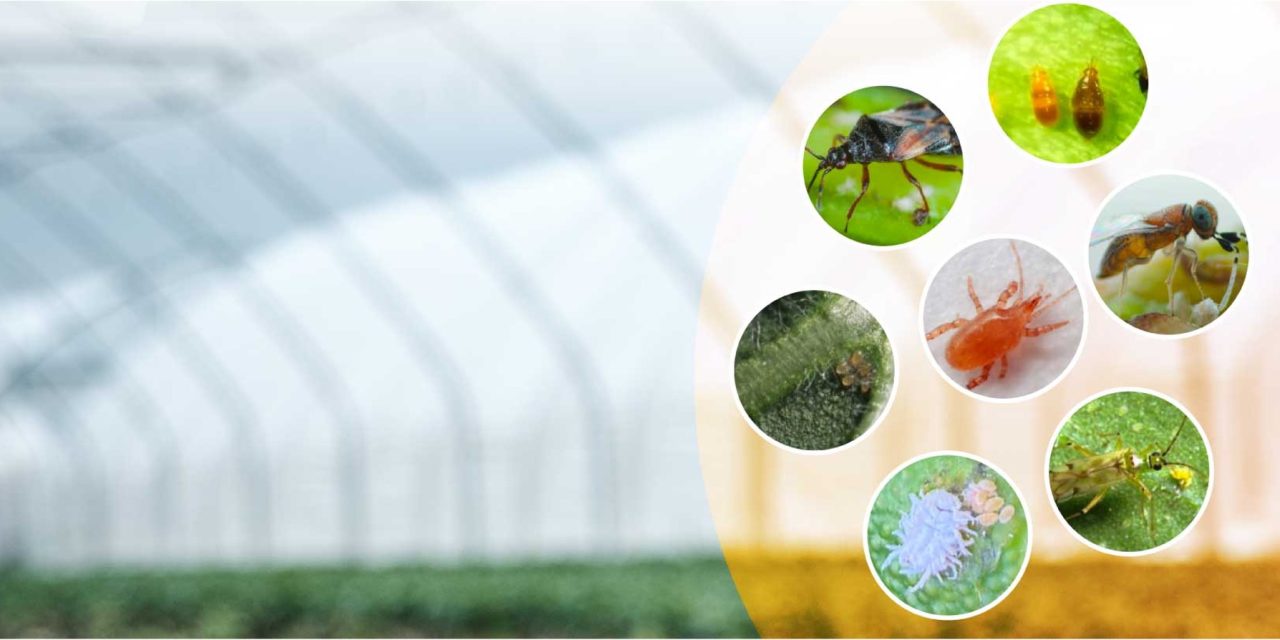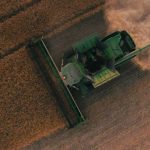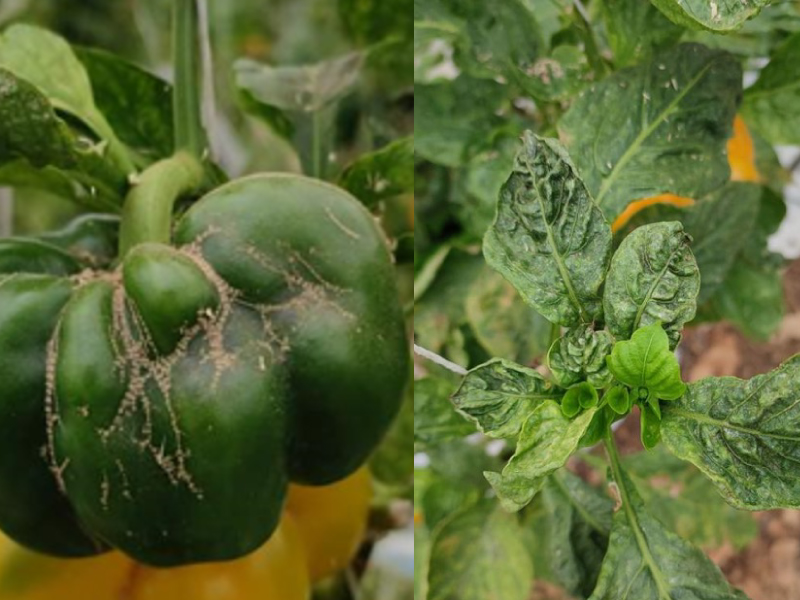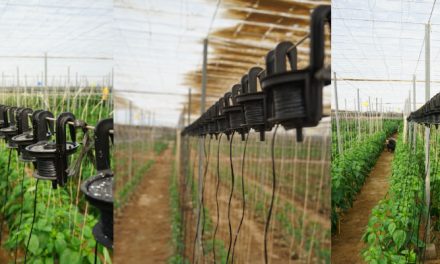
Strategies for the biological control of pests in crops

Biological control is an effective way to manage pests and diseases in crops, either through the use of living organisms such as bumblebees, or other industrial products formulated with non-toxic ingredients, which are increasingly less invasive and more environmentally friendly.
Sara Zapata Montero, specialist in protected crops and biological control at the company Biosur, located in Almeria, Spain, explains what this procedure is all about in this article. Also, the importance of choosing a good agricultural plastic to enhance pest control and achieve successful harvests. If you need advice on the right agricultural plastic for your crop, please do not hesitate to contact us.
In this post we talk about:
- What are the advantages of the biological control of pests?
- What are the main pests in crops?
- What are our main allies in terms of biological control?
- How are auxiliary insects introduced into crops?
- What biological control strategy is being used against the Thrips Parvispinus?
- Is the Tiger Fly or “Coenosia Attenuata” really an ally in terms of the biological control of pests?
- Why is it important to enhance the presence of mites for a more successful biological control of the Thrips Parvispinus?
- What is conservative biological control?
- Advantages of reservoir plants when it comes to the biological control of pests
- What other measures/supplements can be used in the biological control of pests?
- What can be done about the Fruit fly?
- What type of plastic cover should you choose?
- How do chemicals affect the Macrocheles Robustulus or Tripsoil? And how long does it last in the crop or soil?
What are the advantages of the biological control of pests?
- The use of phytosanitary products is considerably reduced to be more environmentally friendly.
- More sustainable production can be achieved.
- Higher-quality harvest products that allow farmers to stand out in the agricultural market.
- A better response to consumer demand, locally and globally, can be achieved by ensuring that products are developed without inconveniences, and on time.
What are the main pests in crops?
According to Zapata, the pests that most frequently affect crops in Almeria are aphids, whiteflies, mites, Lepidoptera, and Thysanoptera. Due to their presence, growers had to implement certain biological pest control strategies to reduce them, which include the use of auxiliary insects.
In the case of aphids, there are two types: large and small ones. However, although the small ones were the ones that affected crops the most, in the latest fall-spring season, it was evidenced that both types of aphids are affecting crops equally.
There are also mites such as the dreaded red and white spiders, which usually generate many problems when their population increases, especially when there is a lack of humidity and extreme heat waves.
The lepidoptera such as the “tuta”, often attack tomato crops specifically, so it is very important to deal with them so that the problem doesn’t escalate.
The whitefly is one of the best known pests, since it affects almost all crops in the Almeria area, and also carries viruses, as is the case with smaller aphids.
The thrips Thysanoptera includes the Thrips Parvispinus, but also the Thrips Frankliniella, which have caused the most damage to crops and carried viruses for years.
What are our main allies in terms of biological control?
Just as there are pests that damage crops, there are other insects that are the natural enemies of those pests, and they are now used by specialists to protect their crops.
According to Zapata, there are two types of allies: predators and other parasitoids.
Following are some of the predators that help with the biological control of pests:
-
Amblyseius Swirskii
It is a highly adaptable, all-terrain mite that belongs to the phytoseiid family. This mite adapts very well to different types of climatic conditions. However, when it is very hot, these insects need additional help to settle in crops.
They are ideal for the biological control of almost all crops, not only in Almeria, but also in other geographical areas, since they feed on whiteflies, thrips larvae, red and white spider mites, lepidopteran eggs, and different types of pests that appear in crops of bell peppers, cucumbers, eggplants, and even, melon and watermelon when the spring arrives.
-
Phytoseiulus Persimilis
This is a mite that is used for very specific purposes since it only feeds on spider mites, which are attacking a lot of crops. It can be differentiated by its pear shape, bright red color, long legs, and high mobility.
It is advisable to use this type of mite in a targeted manner since better results are obtained by considerably reducing spider populations.
-
Orius Laevigatus
This is a species of hemipteran bug that belongs to the Anthocoridae family, which is specifically used to lower populations of adult thrips, larvae, and eggs. Because of its voracity, it is widely used to keep Frankliniella occidentalis and tabaci thrips under control.
-
Nesidiocoris Tenuis
This is a green predatory mirid used in biological control, especially in tomato and eggplant crops. You can begin working with it from the seedbed.
Growers must make sure they are using the appropriate doses, for which the help of a specialist is essential to prevent this insect from becoming a pest.
These mirid are very useful because they can prey on various types of insects and mites such as whiteflies, which are their main prey. They also feed on thrips, lepidopteran eggs, and red spider mites.
-
Neoseiulus Cucumeris
This is a phytoseiid mite that attacks the egg and first stage of thrips, although it also feeds on other pests such as red spider mites, and white spider mites. Its activity and biology are very similar to that of A. Swirskii, but it tolerates low temperatures better and its application is recommended in winter.
-
Chrysoperla Carnea
This is a voracious predator of several species of aphids, thrips, red spider mites, small caterpillars, etc. They are useful in biological control since they also control secondary pests such as Creontiades pallidus and mealybugs. They usually appear spontaneously in farms with greenhouses, especially in spring when there are aphid problems. They reach a large population of adults, are resistant to insecticides, and have important dispersal capacity.
They are recommended for use in crops that experience significant temperature and humidity changes. Their insertion must be done close to the bulbs, since the products are marketed in larvae format, and these have limited mobility capacity.
-
Aphidoletes Aphidimyza
This is a cecidomid dipteran that lives naturally in Europe, North America, and Asia. They are very helpful when it is necessary to lower aphid populations and, unlike other cecidomid species, they don’t cause damage to plants by forming galls on leaves.
It can be applied to various crops to treat any aphid species. Adults feed on nectar and pollen, hence the importance of having reservoir plants with heavy flowering throughout the crop cycle.
-
Adalia Bipunctata
This is a ladybug present throughout Europe that feeds on numerous species of aphids. It prefers sunny regions and relatively dry places with small, sparse vegetation. Both larvae and adults feed on aphids. Females may deposit 20 to 50 eggs per day. These insects are yellow-orange and are located near aphid colonies.
-
Macrocheles Robustulus
This mite was initially developed for the control of sciarid flies in ornamental crops, but then, its efficiency in the control of thrips in soil, since it lives between 1 and 4 cm deep, was evidenced.
It is ideal for biological control in the soil because it feeds on the different lymph stages (prepupae and pupae) of different pests found in the fields, so it is a good tool to support the A. Swirskii, and O. Laevigatus.
The following are some examples of parasitoid allies:
-
Aphelinus Abdominalis
These are adult female wasps that parasitize aphids. They are used for aphid control.
-
Aphidius Colemani
Another parasitoid ally of biological control that helps control aphids, exclusively the small ones (Aphis gossypii and Myzus persicae). This is a small, slender, black parasitic wasp.
-
Aphidius Ervi
Although its morphology is similar to that of Aphidius colemani, this wasp is twice as large, which makes it very useful for controlling larger aphids, e.g., the Macrosiphum euphorbiae and Aulacorthum solani.
-
Eretmocerus Eremicus
This insect is a biological control ally of the parasitoid type used mainly for the control of whiteflies.
-
Diglyphus Isaea
This is a wasp of about 2mm, dark color, with a green metallic shine that controls the leaf Miner moth or insect larvae that live inside the leaf tissue.
-
Aphytis Melinus
This yellowish parasitoid wasp is used primarily to control lice. It has a preference for California red louse and white lemon louse.
For further information on other predator and parasitoid species used in the biological control of pests, we recommend checking this link.
How are auxiliary insects introduced into crops?
Sara Zapata, representative of the company Biosur, recommends above all respecting the safety deadlines of the chemicals used before introducing auxiliary insects in the crops. Otherwise, we will be wasting time, effort, and money.
She also highlights the importance of having the support of professionals who can advise the grower from the beginning to the end of the growing season regarding the right time to release insects based on the safety period, the size of the plant and its flowering, the importance of having reservoir plants, and everything necessary for these insects to have a shelter, free of residues, and a variety of food so that they can adapt well to the environment where they are.
What biological control strategy is being used against the Thrips Parvispinus?
The first thing to do is to identify whether the plant really has the Thrips Parvispinus to know what type of biological control should be used. Sometimes, growers confuse the damage to the leaves of crops such as bell peppers, with the damage caused by the white spider mite, hence the need for the advice of a professional in the area.
One of the recommendations given by Zapata to achieve a crop with the least possible damage from the Thrips Parvispinus is to carry out biological control from the beginning of transplanting, thus avoiding the introduction of the auxiliary insect too late, when the population of thrips is probably larger, and they have already installed in the crop.
In this webinar, you can watch an interesting study that was done in Cartagena, Spain, concerning the life cycle duration of the Thrips Parvispinus at different temperatures and its results.
Another strategy to control this insect is to create biodiversity. In other words, farmers, shouldn’t focus only on introducing predators such as the Orius, which is very useful to considerably reduce the populations of Thrips Parvispinus. These predators must be introduced with the help of other predators such as the Amblyseius Swirskii. The ideal scenario is to have combinations of predatory mites well installed during the whole crop cycle and avoid using phytosanitary products excessively.
Also, spontaneous releases of Orius must be done not only by air but also to perform biological control on the ground with Macrocheles Robustulus for example.
There are microbiological treatments that contribute to dealing with the Thrips Parvispinus through different types of entomopathogenic fungi, which can help via air to control this type of pest in the soil, as well as entomopathogenic nematodes, which help control the pupae and prepupae in the soil.
Another biological control strategy used in crops where the Thrips has taken over, i.e., where leaves and fruits are very affected, is to remove leaves, which will lower the population of Thrips Parvispinus. Then make spontaneous releases of Orius in the same area, and reinforce with mites such as the Swirskii.
In the case of the Macrocheles Robustulus, this is a very voracious macro predator that settles very well in any type of soil, which is introduced along with the Amblyseius Swirskii and Orius. It is a predator of Thrips Parvispinus pupae and prepupae, as well as other pests, being very useful in keeping pests under control.
Is the Tiger Fly or “Coenosia Attenuata” really an ally in terms of the biological control of pests?
According to Zapata, some believe that the Tiger fly or “Coenosia Attenuata” is a helpful ally in the process of biological control. However, although this predator can hunt some whiteflies, some jumping Thrips, or a winged aphid that’s flying, the truth is that when biological control of aphids is desired, either through the installation of different types of flying insects such as the Aphidius Colemani or Aphidius Ervi, the biological control won’t be successful against aphids if the Tiger fly is installed in the crop.
In this case, it’s best to use the Macrocheles Robustulus to eliminate the pupae and prepupae of Thrips Parvispinus, as well as the pupae of Tiger flies to maintain stable levels of Tiger flies in the crops, and to make biological pest control more effective.
Why is it important to enhance the presence of mites for a more successful biological control of the Thrips Parvispinus?
It is of the utmost importance to enhance the presence of mites in the biological control of pests in all types of crops and maintain the same throughout the year, since populations are often affected, either by changes in temperature, climate, or by any chemical treatment that is done on time.
“It is necessary to always boost these mites to keep them throughout the crop cycle. It can be done manually or using an air machine designed to release this type of insect as quickly and homogeneously as possible in the crop,” explains Zapata.
In the case of insects such as the Orius, their population is reduced during periods with less solar radiation and low temperatures, so it is ideal to have the presence of other mites such as the Neoseiulus Cucumeris, specifically for the autumn-winter months (October to February) to keep the Thrips Parvispinus at bay.
What is conservative biological control?
Conservative biological control consists of maintaining the biological control carried out on crops over time. According to Zapata, it’s a waste of time to introduce auxiliary insects such as the Amblyseius Swirskii, Orius, Phytoseiulus, and Chrysoperla in the first months of planting, if when the coldest days of winter arrive those populations start to decline and there is no plan to enhance the presence of mites that can cope with this decline until the spring arrives, which is when aphids, spider mites, and flies reappear. Hence, the need to maintain biological control throughout the crop cycle.
The idea behind the conservative biological control is to attract and install the auxiliary insects in the system, trying to maintain them through the use of less aggressive phytosanitary products that are more respectful of the environment and the insects, making occasional releases, so that the population doesn’t disappear completely, making treatment thresholds, and sowing plants associated with the crop that help attract these beneficial insects to the greenhouses.
There is also the conservative biological control system performed through the use of the banker plant, which is a preventive system that seeks to keep unwanted pests at bay through the pre-installation of auxiliary insects in the crops.
Advantages of reservoir plants when it comes to the biological control of pests:
- They provide shelter and protection for insects, especially during the application of phytosanitary treatments, or during extreme weather conditions.
- They help create a more suitable microclimate for insects.
- They provide an additional source of food: pollen, and nectar.
- Their flowering helps attract predator and parasitoid species to the environment.
- They promote a natural barrier to pests.
- They create the perfect scenario for these insects to reproduce and increase their population.
What types of reservoir plants should be chosen?
- Preferably native or local species that can adapt to the environment.
- Species with available space to grow.
- Species with high flowering that allows the adaptation of auxiliary insects.
- Minimally invasive species.
- Species with low water and nutrient requirements.
- Low-maintenance species.
- Species that can last throughout the crop cycle.
- Species that can be combined so that there is sustained flowering throughout the crop cycle.
- Species in a variety of sizes, i.e., some that grow taller and others that grow shorter to benefit the different types of insects.
The following are some of the reservoir plant species that can be planted inside a greenhouse:
- Sweet Alyssum: attracts insects such as the Orius, Syrphids, Chrysopas, (larvae), Scymnus, Braconidae, and Anystidae.
- Yarrow: attracts Syrphids
- Tagetes: attracts Syrphids, and Chrysopas
- Fennel: attracts Chrysopas, Scymnus, and Aphidoletes
- Sunflower: attracts Chrysopas, Scymnus, and Orius
- Rue: works as an insect repellent
The recommendation is to have 7 or 8 types of reservoir plants in greenhouses to contribute to good biological control.
Guidelines to follow when planting outdoor hedges or delimiting areas:
- Choose native or local species that can adapt to the environment.
- Choose hedges that require little maintenance.
- Prefer hedges with intense and overlapping flowering.
- Choose species that aren’t reservoirs of viruses or other pests that can affect greenhouse crops.
Some of the appropriate plant species to create outdoor hedges are the following:
- Oleander
- Rosemary
- Lavender
- Asteriscus Maritimus
- Creta Trefoil
- Thyme
What other measures/supplements can be used in the biological control of pests?
- Place traps and pheromones timely to attract and sexually confuse unwanted pests.
- Provide “hotels” for those insects that help auxiliary insects to have shelter.
- Install nests of species that feed on these pests such as bats, and insectivorous birds.
For more information, we recommend reading our article on pest control management plan for the growing season.
What can be done about the Fruit fly?
The Fruit fly, or Ceratitis Capitata, has caused many problems in crops, especially when there’s extreme heat.
In this case, Zapata recommends the use of sexual attractants, pheromones with their integrated insecticide, and placing at least 20 traps per hectare at the beginning, and then increasing to 80 traps per hectare.
What type of plastic cover should you choose?
It is crucial to choose a plastic cover that is suitable not only for the crop but also for the auxiliary insects that live there. The solar radiation spectrum and its effect on the crop must be considered, since in the case of UV rays these have a great energetic power that the auxiliary insects and pollinators need to carry out their work in terms of biological control.
“There are plastics that are adapted with certain types of additives where UV rays and PARs are not affected, thus preventing the interference with the biological control process carried out by us and by auxiliary insects,” explained Zapata.
Agricultural plastics are great allies that help, for example, to disinfect soils before cultivation, but also to enhance the work of pest control. We invite you to read some of the posts we have related to this topic:
- Totally Impermeable Films (TIF) why can they help me disinfect my crops?
- Controlling weeds in strawberry crops
- Pest control in cannabis crops
How do chemicals affect the Macrocheles Robustulus or Tripsoil? And how long does it last in the crop or soil?
Chemicals in general affect any type of auxiliary insect since their function is to affect the insect (whether the insect is beneficial or harmful to the crop). However, in the case of the Macrocheles Robustulus, as it is introduced through the soil, it is usually protected against different types of treatments, especially when there are plants large enough to prevent the treatment from reaching the insect.
If you would like to learn more about the biological pest control of pests, we recommend that you watch our webinar on this topic.





![[eBook] Sustainability and water management](https://agriplasticscommunity.com/wp-content/uploads/8_550x310_ENG-440x264.png)
![[eBook Trends in Agriculture Plastics] Increasing use of biodegradable mulch](https://agriplasticscommunity.com/wp-content/uploads/550 × 310_2_ENG-440x264.png)
![[eBook Trends in Agriculture Plastics] Reducing the plastic used in the manufacture of agricultural films](https://agriplasticscommunity.com/wp-content/uploads/550 × 310_1_ENG-150x150.png)
























